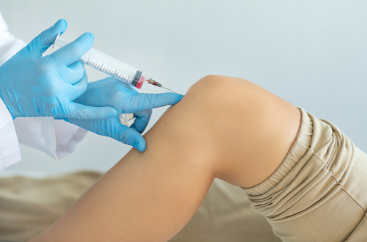
Pain relief has changed through the years. Advancements in medicine, particularly in orthopedics, have allowed us to transition from masking pain and invasive procedures to injectable solutions that use your own cells, such as PRP injections and stem cell therapy. Before settling for either treatment, you should educate yourself to see how PRP therapy and stem cell therapy compare.
General Information
Both stem cell therapy and PRP injections are part of regenerative medicine. Stem cells are in your body already. They’re cells that don’t have a specific function, but have the ability to change into the types of cells your body needs. In our stem cell treatments, they can become muscle, ligament, or tendon cells that help heal injuries.
PRP injections, also known as platelet-rich plasma injections, consist of platelet-rich plasma taken from your blood. The plasma contains platelets that have growth factors responsible for blood clotting and healing when you get injured.
Conditions Treated
Both of these treatments are used to treat a plethora of conditions and injuries in many subfields of medicine and cosmetics. Your orthopedic doctor may use PRP therapy to help with osteoarthritis, as well as acute and chronic soft tissue injuries. Stem cell therapy can also be used for arthritis and acute and chronic soft tissue injuries.
Preparation for the Injections
No matter which treatment you receive, you’ll undergo a physical exam and a comprehensive evaluation to determine if the procedure is appropriate and safe for you. After that, the processes are slightly different based on the option you and your practitioner decide is right for you.
PRP Injections
The process for PRP begins with your practitioner drawing blood from your arm. Your doctor may take more than one tube of blood. Your blood then goes into a centrifuge, which separates the components based on density. Here, your platelets separate from the rest of the blood content. Then, your platelets are taken out and used to create the PRP injection.
For the actual procedure, your practitioner will clean the area where they will inject the PRP. Next, your doctor will numb the area where you receive treatment, if necessary, or use an imaging tool to guide the injection in the right place. The growth factors in the platelets will trigger and boost healing over the next few weeks.
Stem Cell Therapy
Your doctor will extract your stem cells from bone marrow or fat deposits, depending on which is most appropriate for you. Your doctor will then clean the site where you have pain and other issues, and will inject the stem cells into the place where you have degenerative, damaged, or diseased tissue. The stem cells will encourage the growth of new tissue over the next few weeks, which helps with healing.
Safety of the Treatments
Both of the treatments are relatively safe. Since you’re using your own cells, the risk of you having an allergic reaction is extremely low. You might have temporary pain or discomfort at the injection site, but no serious issues, such as incisions or scars are involved. You have a very low risk of developing an infection, and our practitioner takes the necessary steps to further minimize this risk.
Why Choose Our Austin, TX Orthopedic Surgeon for Regenerative Medicine
The orthopedic experts at All-Star Orthopedics of Austin offer both PRP therapy and stem cell therapy to patients. We offer state of the art treatments and various services to help you heal better and quicker. Schedule an appointment with All-Star Orthopedics of Austin, serving Austin and the nearby area, to see if PRP therapy or a stem cell treatment could relieve your pain. Contact us at 512-346-4933, or use our online scheduling tool.





